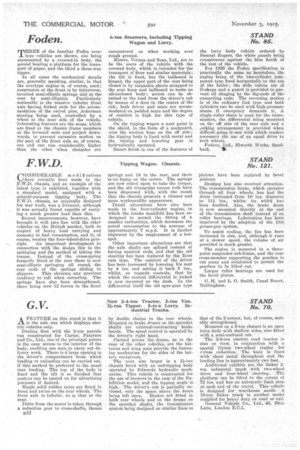Foden.
Page 18

If you've noticed an error in this article please click here to report it so we can fix it.
TIIREE of the familiar Focfen overtype vehicles are shown, one being surmounted by a covered-in body, the second hearing a platform for the transport of paper, and the third a three-way tipper.
In all cases the mechanical details are, generally speaking, similar, in that the overtype engine is, of course, used ; suspension at the front is by transverse, inverted semi-elliptic springs and at the rear by semi-elliptics. Particularly noticeable is the massive tubular front axle having forked ends for the accommodation of the swivel pins, Ackerman steering being used, controlled by a wheel at the near side of the vehicle. Interesting features are the stops, which are fixed to the chassis frame members at the forward ends and project downwards, to prevent excessive motion an the part of the front axle as, of course, one end can rise considerably higher than the other when obstacles are encountered as when working over rough ground.
Messrs. Vernon and Sons, Ltd., are to be the users of the vehicle with the covered body, which is intended for the transport of Hour and similar materials ; the tilt is fixed, but the tailboard is hinged, the upper part of the rear being closed in by tarpaulin sheets strapped to the rear hoop and tailboard to make an all-enclosed body; access. can be obtained to the load from the driver's cab by means of a door in the centre of the cab; both driver and mate are accommodated on padded seats and the degree of comfort is high for this type of vehicle.
On the tipping wagon a neat point is the shield, in the form of a mudguard, over the suction hose on the off side ; the tipping body is lined with metal and the _ raising an d lowering gear is hydraulically operated.
Smart finish is one of the features of the inlay body vehicle ordered by Samuel Rogers, the white panels being conspicuous against the blue finish of the rest of the vehicle.
For 1926 the Foden specification is practically the same as heretofore, the engine being of the tivo-cylinder compound type fixed horizontally to the tap of the boiler ; the slide valves are of D-shape and a guard is provided to prevent oil slinging by the big-ends of the connecting rods. The reversing motion is of the ordinary link type and both cylinders can be used with high-pressure steam if emergency demands it. A single roller chain is used for the transmission, the differential being mounted on the off side of the rear axle and ..ocking arrangement is provided when difficult going is met with which -renders necessary the use of an equal drive to both whaels.
Fodens, Ltd., Elworth Works, Sandbach.
















































































